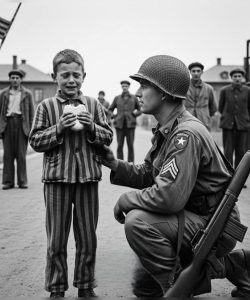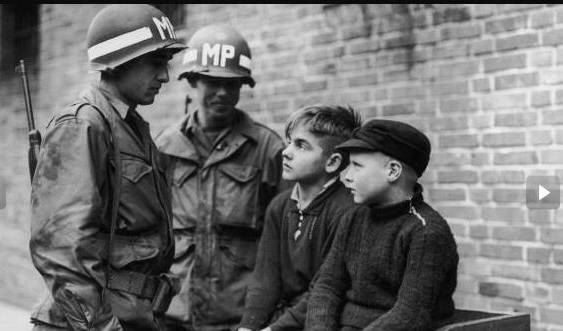The Hand of Freedom: A Single Act of Kindness at the Gates of Hell

The world is often defined by its extremes, and nowhere was that contrast more chillingly captured than in a single, timeless black-and-white photograph taken in the final, desperate days of World War II. It captures the instant the absolute darkness of the Holocaust met the hesitant, terrifying light of freedom.

In the center of the frame stands a young, painfully emaciated boy. He is still dressed in the thin, dehumanizing striped uniform of a concentration camp, a ghostly shroud of a regime that sought to erase his identity. His small hands clutch a piece of bread—a simple, life-giving object he probably hasn’t seen in months, a treasure more valuable than gold. His face, gaunt and aged beyond his years, is contorted in a silent, heartbreaking cry. It is a soundless scream of disbelief, exhaustion, and the sudden, traumatic rupture of a world defined only by terror.
The Meeting of Two Worlds

Kneeling before him is an American soldier, his helmet and uniform marking him as a liberator from a world the boy had forgotten existed. The soldier’s face is a canvas of emotion: a mix of profound pity, horror at the scale of the evil he had just witnessed, and gentle, human compassion.

With infinite care, the soldier gently places a large, reassuring hand on the boy’s shoulder. It is a simple gesture—a touch—yet it is an act of monumental human kindness in the face of unimaginable, systematic evil. It is the first safe contact the boy has likely experienced in years, a physical sign that the reign of cruelty is over.

In the background, other prisoners emerge from the wreckage, their faces hollowed by starvation and suffering. They stand watching this interaction, their eyes slowly, cautiously, filling with the dawning, fragile hope of rescue. They are hesitant, conditioned by years of brutality to fear every uniform, yet mesmerized by this simple act of shared bread and human touch.
The Icon of Liberation

This image is not just a photograph; it is an icon of liberation, capturing the exact moment a child’s world shifts—from the daily, crushing terror of the camp to a sudden, confusing influx of safety and nourishment. It illustrates the raw, immediate conflict between the desire to flee and the dawning realization that they are finally safe.

The scene serves as a powerful, humbling reminder. It recalls the extraordinary sacrifices made by Allied soldiers to defeat tyranny, and underscores the fundamental, resilient goodness found in the hands of a rescuer. The true victory, the image suggests, was not just the military defeat of an empire, but the restoration of human dignity, one fragile life at a time.
The boy’s tears and the soldier’s gentle hand remain a timeless testament: the light of compassion will always break through the darkest night.